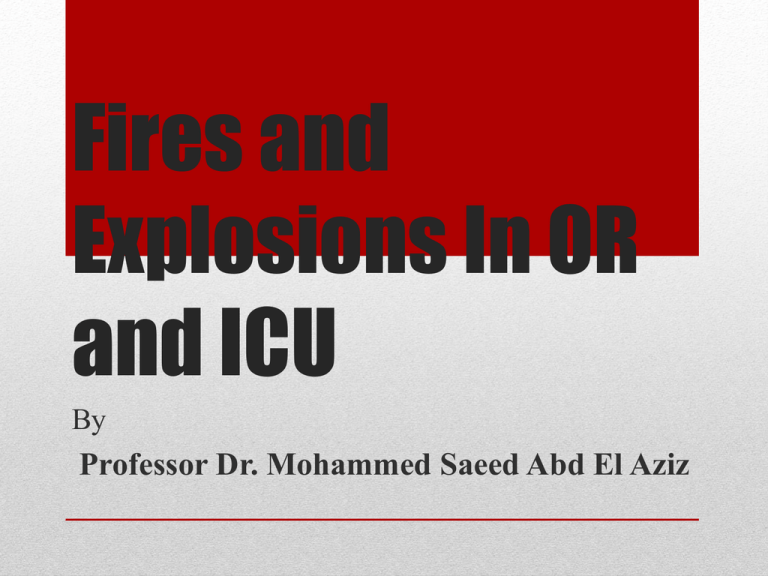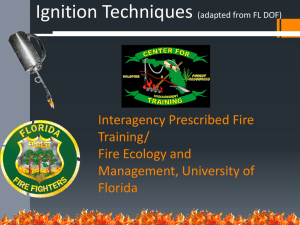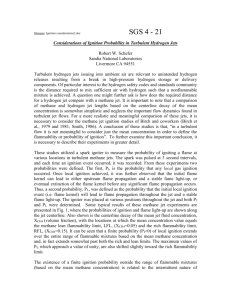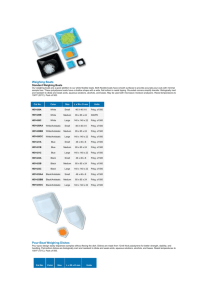Fires and Explosions
advertisement

Fires and Explosions In OR and ICU By Professor Dr. Mohammed Saeed Abd El Aziz • General principles • Combustible agent or fuel + O₂ or oxidizing agent → reaction products + energy. • Activation energy • Heat energy → ↑ temp. of the mixture which when exceed certain level → self sustained • 2 C₃ H₆ + 9 O₂ → 6 CO₂ + 6 H₂O+ Energy • Cyclopropane to O₂ 18% or 2:9 → Stoichiometric concentration. • 2 Vols + 9 Vols → 11 Vols • It is the concentration at which all the combustible vapor and oxidizing agent are completely used up → Stoichiometric concentration. • Stoichiometric mixtures→ the most suitable mixture for ignition. • Different mixtures → less violent reaction or no ignition. • Flammability limit is the limit outside which the mixture will not burn. • Cyclopropane • Lower flammability limit limit 2.5% upper flammability 2:9 18% 63% In O₂ 2.5% 4.3% 100% In air Lower flammability limit upper flammability limit limit stoichiometric limit concentration No ignition Fire Explosion Fire No ignition Fire Explosion • Speed low high • Pressure 1 bar 25 bar • • • • Temp. 200-500 C⁰ 3000 C Light Less More Sound waves minimal maximal In normal anesthetic practice, cyclopropane burns but not explodes in air. • Flammability range is reduced and stoichiometric conc. Is altered. • The inert nitrogen molecules absorb energy+ does not take part in the reaction; reaction is less violent. • 2C₃ H₆+ 9O₂ +36 N₂→ 6 CO₂ + 6 H₂O+ 36 N₂ + Energy _________ 9( O₂ + 4 N₂ ) Nitrous oxide is an oxidizing agent, rapidly breaks down in the presence of heat of fire or explosion to release O₂→33 % O₂ mixture→ more energy 2 N₂O = 2 N₂ + O₂ +Energy ie, more violent reaction in the presence of N₂O and release more energy. • Other Flammable Agent • Ether Lower flammability limit limit upper flammability Stoichiometric conc. 2% 14% 82% 100% in O₂ 2% 34% 100% in air Ether does not explode in air but burns. The conc. Of ether in oxygen used in anesthesia→ within limits for explosion. • If liquid ether split→ high conc. Of ether vapour near the floor→ approach high flammability limit in air → burn→ cool flames, it is invisible and at lower temp. level. • Ether→ CO₂ + H₂ O , this in normal reaction, but in • Cool flames → oxidation is partial→ acetic acid and acetaldehyde. • Cool flames→ transmit risk of ignition to anesthetic circuit (breathing system) • Flame : is a combustion associated with emission of light and heat , a- static (confined) b- self- propagated. • The Fire Triad a-Fuel b- a source of ignition or heat. C- an oxidizer • Other Flammable Agents (Fuel) • • • • Ethyl Chloride Ethylene Vinyl ether, they are less commonly used. Halothane and trichloroethylene → suitable mixture and suitable temp.→ ignition but not in concentration used in anesthetic practice. • Anesthetic agents now are not flammable but other agent, like ethyl alcohol, are flammable. • Saturated vapour of alcohol in air in normal room temp. 6% mixtures • Stoichiometric conc 0% 3% 6% 19% alcohol in ↓ air Fire risk of saturated vapour at room temp. Surgical spirit Methane- hydrogen in patient’s gut with diathermy→ fire. Ethyl chloride→ anesthetic spray. Paper, plastic drapes, dressings. Pure O₂+ pressure +high speed → high fire and explosion risk, oil and grease must be avoided in any O₂ supply system. • Activation Energy and Ignition Temperature • Combustible agent + O₂, they are apart by repulsive forces and in order to burn molecules should be close enough to react → ↑ the speed of collision →↑ temp. by spark or some source of heat ( enough heat to reach activation energy). • Ignition temperature:- the temperature at which a mixture must be raised for combustion to start. • It varies with components and proportion of potentially explosive mixture. • Stoichiometric conc. Of many explosive mixture temperature is about 400 C⁰ but ether-O₂ mixture is low as 150 C⁰ . • Spirit lamb, diathermy, Lasers→ ignite flammable materials. • Sparks→ activation energy→ activate an ether O₂ explosion when present in stoichiometric conc. (spark is around 1 microjoule in value but it has a high voltage , it is more risky than hot wire or open flame) • Static Electricity • Important source of sparks • Conductive floor, low resistance → ↑ electric risk , high resistance↑ build up of static electricity. • Antistatic rubber. Soled shoes contain carbon. • ETT conduction by humidified gases passing through it. Equipments→ sparks or static electricity. 2 types of flammable mixtures -mixtures with oxygen or nitrous oxide as oxidizing agent. -mixtures with air, activation energy is less in the first one. Flammable mixtures near anesthetic machines 5cm-25cm. Category of equipment →APG (avoid ignition with O₂ or nitrous oxide- green band) green circle) AP (avoid ignition with air- Types of operating room fires A -Fires in the patient 1- Laser a- upper airway surgery b- lower airway surgery 2-Electrocautry a- during tonsillectomy b- during laparoscopic surgery c- during tracheostomy. B- Fires on (outside) the patient 1- During monitored anesthesia care(MAC) for head and neck surgery 2- During skin preparation using isopropyl alcohol. • Safety precaution to prevent fires and explosions • 1- Avoidance of the use of flammable anesthetic agents ( C-F bond) decrease flammability. • The use of sources of ignition such as diathermy or laser under controlled conditions. • Use the Iow-flow or closed circuits. • Allow good ventilation of OR. • Use a well functioning scavenging system. • 2-Classification of equipments according to the zones of risk: 5 cm zone (anesthetic mixtures is high and oxidizing agent O2 or N2O), 25 cm zone (anesthetic mixtures is low and oxidizing agent is air), APG( 5cm) and AP (25 cm) equipment • 3-Prevention of electric sparks • PPM (periodic preventive maintenance) • Spark –proof mercury switches. • Dry battery. • 4-Prevention of static electricity (antistatic materials) • Antistatic floors, antistatic breathing circuits, antistatic cloths, antistatic wheels, antistatic rubber-soled shoes, relative humidity less than 50% and grounding or earthing. • 5-Fire-fighting equipments (fire extinguishers) • Should be available all the time, class A –B- C e g, Halon fire extinguisher, CO2 extinguishers and pressurized water. • 6- Precaution during laser surgeries. • Extinguishing a fire • • • • • 1-Remove oxidizing agents. 2-Remove burning drapes. 3-Use a fire blanket. 4-Sprinkler system. 5-Halton fire extinguishers are used. Thank you








